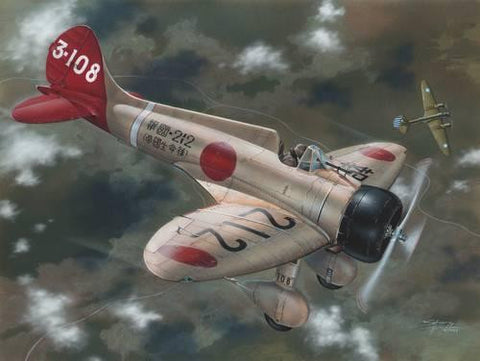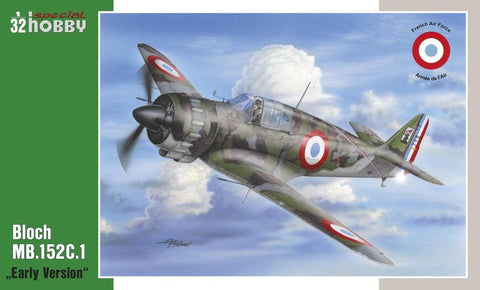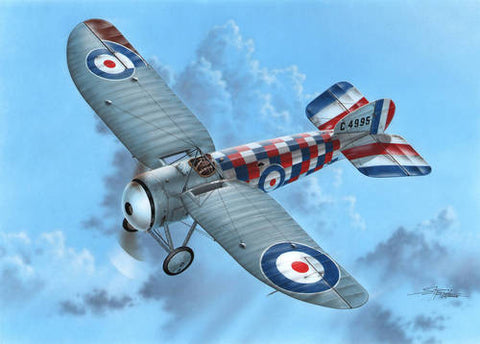
Special Hobby Aircraft 1/72 FH1 Phantom USN Demonstration Teams & Trainers Jet Aircraft Kit
This Product Usually Ships In 2-3 Business Days
SHY-72297The first US Navy’s jet aircraft to be operated from the aircraft carriers and the first jet of the US Marines ever, such could be the description of the airframe produced by McDonnell under designation the FH-1 and which was commonly known as the Phantom, although the same name, just with a number II added, would be later given to another and much more popular jet to seemingly eclipse the historic significance of the original Phantom.
McDonnell company was established in 1939, and in 1940 it received its first contract for a production of subassemblies for other producers. In January 1943, McDonnell’s design team was assigned a new job though. The US Navy commissioned a jet fighter aircraft to be built which was to be known as the FD-1, later to be renamed to the FH-1 in 1947 (in US Navy system, the letter D denoted the Douglas company)
The team, led by K.Perkins, put forward a concept of a straight wing monoplane of all-metal construction. The power plants were supplied by Westinghouse. Originally, before the whole concept of the aircraft became clear enough, as many as eight engines were considered per each machine. Eventually, a more conventional design with two power plants on either side of the fuselage was accepted. The machine was fitted with six machine guns in the nose section and the Phantom military nickname was chosen. The type’s Model 19 powerplants proved to lack the necessary performance and were quite unreliable, too. However, the prototype XFD-1 machine begun its taxiing tests fitted with this type of power plants, to be more precise it was fitted with just one engine. On 26 January 1945, an accidental hop occurred during taxiing which was considered the type’s very first to take off. The flight tests went on until 1 November 1945 when the plane crashed, killing its pilot, W.Burke. It was hard times for the company, indeed. The original order calling for 100 examples of the aircraft was cut down to just 30 airframes by the end of the war, however, eventually, as many as 60 airframes were requested. The flight tests went on with the second prototype, during these tests the very first landing and consequent take off from an aircraft carrier occurred, making the Phantom the very first naval jet aircraft to achieve this milestone.
The production machines differed from the prototypes by having their tail fins squared off, the windshield was simplified, fuel tanks enlarged and a provision for another tank carried under the belly was also made. The very first production airframes, the FH-1, went to VF-17 unit, making it the first jet aircraft unit of the US Navy. The unit was later re-equipped with the more modern Banshee type and renamed to VF-171. The second Navy unit to operate the Phantom was VF-172, while the first Marines unit to do so was VFM-122, which, led by ace pilot Marion E. Carl received their FH-1s during the Autumn of 1947. It was also this unit where the first FH-1 display or aerobatics group was formed, named the Marine Phantoms. Another one was established at the Naval Air Test Center at Patuxent River, named the Gray Angels, but was also unofficially known as the Admirals‘ Group as its members were Rear Admirals D.Galler, E.A. Cruise and A.Soucek.
The FH-1 Phantom did not see very long first line service, it was transferred to Naval Air Reserve units at various Naval Air Stations throughout the whole US rather soon and by 1955, the Phantom had retired from active service. In 1964, two airframes and another one to supply spare parts were used to civil jet pilot training by Progressive Aero Inc. company.
McDonnell company was established in 1939, and in 1940 it received its first contract for a production of subassemblies for other producers. In January 1943, McDonnell’s design team was assigned a new job though. The US Navy commissioned a jet fighter aircraft to be built which was to be known as the FD-1, later to be renamed to the FH-1 in 1947 (in US Navy system, the letter D denoted the Douglas company)
The team, led by K.Perkins, put forward a concept of a straight wing monoplane of all-metal construction. The power plants were supplied by Westinghouse. Originally, before the whole concept of the aircraft became clear enough, as many as eight engines were considered per each machine. Eventually, a more conventional design with two power plants on either side of the fuselage was accepted. The machine was fitted with six machine guns in the nose section and the Phantom military nickname was chosen. The type’s Model 19 powerplants proved to lack the necessary performance and were quite unreliable, too. However, the prototype XFD-1 machine begun its taxiing tests fitted with this type of power plants, to be more precise it was fitted with just one engine. On 26 January 1945, an accidental hop occurred during taxiing which was considered the type’s very first to take off. The flight tests went on until 1 November 1945 when the plane crashed, killing its pilot, W.Burke. It was hard times for the company, indeed. The original order calling for 100 examples of the aircraft was cut down to just 30 airframes by the end of the war, however, eventually, as many as 60 airframes were requested. The flight tests went on with the second prototype, during these tests the very first landing and consequent take off from an aircraft carrier occurred, making the Phantom the very first naval jet aircraft to achieve this milestone.
The production machines differed from the prototypes by having their tail fins squared off, the windshield was simplified, fuel tanks enlarged and a provision for another tank carried under the belly was also made. The very first production airframes, the FH-1, went to VF-17 unit, making it the first jet aircraft unit of the US Navy. The unit was later re-equipped with the more modern Banshee type and renamed to VF-171. The second Navy unit to operate the Phantom was VF-172, while the first Marines unit to do so was VFM-122, which, led by ace pilot Marion E. Carl received their FH-1s during the Autumn of 1947. It was also this unit where the first FH-1 display or aerobatics group was formed, named the Marine Phantoms. Another one was established at the Naval Air Test Center at Patuxent River, named the Gray Angels, but was also unofficially known as the Admirals‘ Group as its members were Rear Admirals D.Galler, E.A. Cruise and A.Soucek.
The FH-1 Phantom did not see very long first line service, it was transferred to Naval Air Reserve units at various Naval Air Stations throughout the whole US rather soon and by 1955, the Phantom had retired from active service. In 1964, two airframes and another one to supply spare parts were used to civil jet pilot training by Progressive Aero Inc. company.
There are three sprues of grey injected molded styrene, one clear sprue and on top of it also a fret of etched details. The decal sheet was expertly printed by Italian Cartograf and caters for four machines, three of which are in the military standard of dark blue while the fourth option portrays a civilian machine in white overall with red trim. Make your choice from the following options:
- No. 750 operated by the NATC and flown by Rear Admiral Apollo Soucek, member of the Gray Angels aerobatics and display team.
- No. 108 assigned to Naval Air Station Grosse Ile, 1951, with the fuselage band in Orange. On the occasion of a public show, this airframe was carried an enlistment poster underneath its canopy, the poster is also in the decal sheet.
- A-FH-1 of the Marine Phantoms display team of VMF-2, with yellow trim.
- FH-1 Phantom, N2482A, as used for the pilot training in Teterboro School of Aviation.











